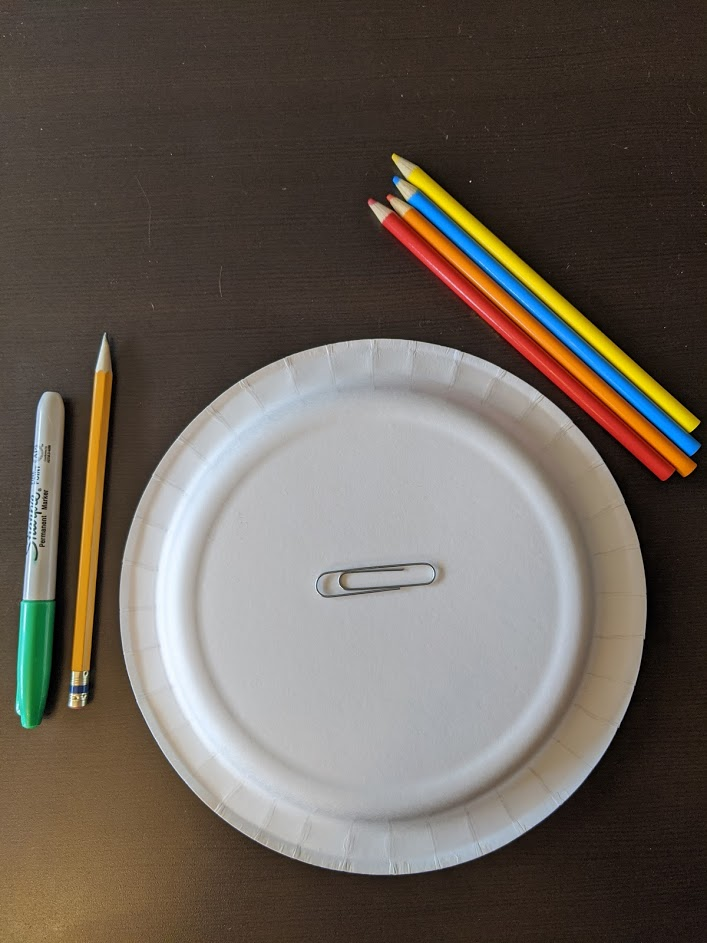In Partnership with The Living Lab
Written by Frankie Garcia & Courtney Paulus
Materials:
1 paper plate1 bold marker 1 paper clip1 pencil Coloring tools (pencils or markers)

Length:
Prep: 5 minutes
Play Time: Unlimited!
Academic Subject(s):
This project targets children ages 4-7
- Art
- English language Arts
- Cognition (emotional awareness)
- Motor skills
Introduction: This special “Sanity Saver” blog entry is based on the Living Lab project originally planned to be implemented with our visitors in Spring of 2020. The Living Lab is a collaborative project between UB’s Early Childhood Research Center (ECRC) and Explore & More – The Ralph C. Wilson, Jr. Children’s Museum.
The Living Lab is designed to bring child development research and knowledge directly to you through play-like experiments with your child! In each of the Living Lab sessions, UB graduate student researchers would engage your child in a brief and play-like experiment based on cutting-edge research. They would then explain to you the purpose of the experiment and why it is important. In addition, they would provide some fun activities and ideas for you to try at home to facilitate your child’s learning and development.
Since all in-person activities are on hold the ECRC and E&M partnered together to still be able to reach you in your living room! The UB student researchers have created fun and engaging activities based on their research experiments. We hope you will try them out.
As Explore & More’s community partner, ECRC also welcomes you to check out its online resources and activities for young children (ages 2-6) and their parents and caregivers; for more information click here.
There is never a better time to start talking with our kiddos about all of the different emotions that they are experiencing, and what is a better way to do it than through a fun game? Talking about emotions helps children become more aware of the causes and effects of different emotions, which can help with emotional regulation.
Creating this fun spinner helps make these conversations more light-hearted and game-like! Simply have your child spin the wheel and describe, draw, or act out a time when they felt the emotion the paper clip lands on. Then, talk to your child about why they felt that way. Through rich conversations with children, caregivers can help foster strong emotional development and help their children make sense of their emotions.
Directions:
Step 1: Flip the paper plate upside-down to use the back. Using the bold marker, divide the plate into four quadrants by making a plus sign that meets in the middle of the plate. (If you prefer to analyze more emotions, divide the paper plate into as many sections as emotions desired!)

Step 2: In each quadrant, use the bold marker to draw a facial expression that will match the emotion you are planning to ask your child about. In the example here, the emotions used are happy, sad, mad, and surprised. Color in the quadrants with markers or colored pencils to make the spinning wheel more fun!

Step 3: Place one round side of the paper clip on the center of the paper place where the lines meet. Place the tip of a pencil through the round end of the paperclip so that it is resting on the paper plate. You now have a spinner that you can flick!

Step 4: Have your child flick the paper clip and watch it spin! When the paper clip lands on an emotion, ask your child about a time when he/she/they felt that emotion and why they felt that way. This will give you a better idea of your child’s emotional development, while also opening communication even more between you and your child. Your child will love telling stories and making the connection between the story details and emotions felt. For additional fun, have your child draw, act out, or come up with a fictional story that would evoke the emotion that they landed on.
Vocabulary Words:
1. Emotion: “A state of feeling”
2. Expression: A Look on someone’s face that conveys a feeling
3. Surprise: “The feeling caused by something unexpected or unusual”
4. Problem: A source of confusion or unhappiness
5. Solution: “An action or process of solving a problem”
(“Dictionary by Merriam-Webster… “, n.d..). Resources:Dictionary by Merriam-Webster: America’s most-trusted online dictionary. (n.d.). Retrieved from https://www.merriam-webster.com/
